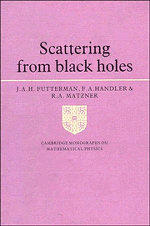Book contents
- Frontmatter
- Contents
- Acknowledgements
- Foreword
- 1 Introduction
- 2 Perturbations of black hole spacetimes
- 3 Integral spin plane waves in black hole spacetimes
- 4 Neutrino plane waves
- 5 Scattering
- 6 Limiting cross sections
- 7 Computation of cross sections
- 8 Absorption, phase shifts and cross sections for gravitational waves
- 9 Conclusion
- Appendix A1 Integrals used to express plane waves in terms of spin-weighted spheroidal functions
- Appendix A2 Addition formulae for spin-weighted spherical angular functions
- Appendix B
- References
- Index
Foreword
Published online by Cambridge University Press: 04 August 2010
- Frontmatter
- Contents
- Acknowledgements
- Foreword
- 1 Introduction
- 2 Perturbations of black hole spacetimes
- 3 Integral spin plane waves in black hole spacetimes
- 4 Neutrino plane waves
- 5 Scattering
- 6 Limiting cross sections
- 7 Computation of cross sections
- 8 Absorption, phase shifts and cross sections for gravitational waves
- 9 Conclusion
- Appendix A1 Integrals used to express plane waves in terms of spin-weighted spheroidal functions
- Appendix A2 Addition formulae for spin-weighted spherical angular functions
- Appendix B
- References
- Index
Summary
The title says it all. Scattering, a powerful tool conceptually as well as experimentally, is applied to the simplest gravitational system, a black hole.
This study benefits gravitation, our best known and least understood phenomenon. Gravitational studies are often isolated from the mainstream of physics. This is how it should be occasionally; one needs to develop a consistent formalism per se; but one needs also to confront it with particle physics, cosmology, astrophysics. A knowledge of cross sections for the scattering of waves of arbitrary polarization by Schwarzschild and Kerr black holes contributes to the physical understanding of gravitation theory.
This study also benefits scattering theory. Starting with the simplest case, the scattering of massless scalar waves by a Schwarzschild black hole, the authors identify the scattering problems which have to be solved: How does one formulate scattering theory in curved spacetime? Can one define an incident plane wave in the long-range Newtonian field of a black hole? How does radiation propagate near a black hole? How does one handle the black hole horizon? How does one compute cross sections for polarized waves propagating in curved space-time etc…? The authors introduce several methods for solving these problems: wave mechanical scattering, partial wave decomposition, semiclassical methods, Newman–Penrose formulation of wave propagation (made powerful by Teukolsky's and Press’ separation into radial polar and axial harmonics of the equation describing the evolution of wave perturbations in black hole background), and Chandrasekhar's and Detweiler's metric perturbation formalism. Numerical computations are not always of less fundamental importance than mathematical investigations; they also suggest new analytic approaches.
- Type
- Chapter
- Information
- Scattering from Black Holes , pp. ix - xPublisher: Cambridge University PressPrint publication year: 1988



